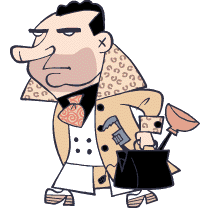"Clothes are freedom—freedom to choose how we present ourselves to the world; freedom to blur the lines between man and woman, old and young, rich and poor."
Here's what to say the next time somebody rags on about the kids and adults these days with their droopy pants and turned-around baseball caps...
This pretty much nails the clothing revolution of the past 40 or so years:
Americans dress casual. Why? Because clothes are freedom—freedom to choose how we present ourselves to the world; freedom to blur the lines between man and woman, old and young, rich and poor. The rise of casual style directly undermined millennia-old rules that dictated noticeable luxury for the rich and functioning work clothes for the poor. Until a little more than a century ago, there were very few ways to disguise your social class. You wore it—literally—on your sleeve. Today, CEOs wear sandals to work and white suburban kids tweak their L.A. Raiders hat a little too far to the side. Compliments of global capitalism, the clothing market is flooded with options to mix-and-match to create a personal style.
That's Deirdre Clemente writing at Zocalo and Time. She's the author of Dressing Casual: How College Kids Redefined American Style and she comes out and admits upfront that she owns "17 pairs" of sweatpants. "For me," she writes, "casual is not the opposite of formal. It is the opposite of confined."
Preach it, sister. Clemente's essay reminds me of Tom Wolfe's 1976 New York magazine piece that popularized the slogan "the Me Decade" (despite his signature snark, he saw it in mostly positive terms). As many observers yammered on about economic malaise and inflation (which were definitely real problems), Wolfe focused on how the proliferation of cheap clothing and other accoutrements of style become democratized for the first time in U.S. history:
In America truck drivers, mechanics, factory workers, policemen, firemen, and garbagemen make so much money—$15,000 to $20,000 (or more) per year is not uncommon—that the word proletarian can no longer be used in this country with a straight face. So one now says lower middle class. One can't even call workingmen blue collar any longer. They all have on collars like Joe Namath's or Johnny Bench's or Walt Frazier's. They all have on $35 Superstar Qiana sport shirts with elephant collars and 1940s Airbrush Wallpaper Flowers Buncha Grapes and Seashell designs all over them.
Indeed, he argued that "The new alchemical dream is: changing one's personality—remaking, remodeling, elevating, and polishing one's very…and observing, studying, and doting on it. (Me!)" The massive, ubiquitous, and relatively fast rise in post-war living standards allowed more and more of us to do what rich people had always done: invent our own rules.

Read Wolfe's whole essay, which I've argued elsewhere (both in The Declaration of Independents with Matt Welch and at the late and lamented site Suck.com) is still the essential key to contemporary America:
Intellectuals, artists, and architects, Wolfe notes, had always had great plans to "pygmalionize" the common man. "But once the dreary little bastards started getting money in the 1940's, they did an astonishing thing — they took their money and ran! They did something only aristocrats (and intellectuals and artists) were supposed to do — they discovered and started doting on Me! They've created the greatest age of individualism in American history! All rules are broken!"
A quarter of a century after The Me Decade was so named, Wolfe's analysis is more relevant than ever: We are that much richer still, that much more all aristocrats now, and never less likely to heed the call of "remoralization" emanating from a wealthy Beltway pundit.
Related: That time Alan Simpson literally talked about the kids today "who are walking on their pants with their cap on backwards listening to the Enema Man and Snoopy Poopy Poop Dog."


Show Comments (127)